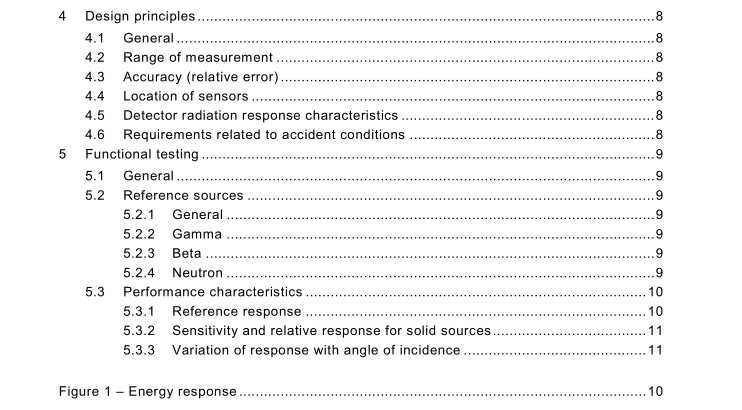BS IEC 60951-3:2009 pdf download – Nuclear power plants – Instrumentation important to safety – Radiation monitoring for accident and post-accident conditions — Part 3: Equipment for continuous high range area gamma monitoring
3 Terms and definitions For the purposes of this document, the terms and definitions given in IEC 60951 -1 apply.
4 Design principles
4.1 General The general requirements of IEC 60951 -1 are applicable to all types of monitors within the scope of the present standard, unless otherwise stated.
4.2 Range of measurement The purchaser shall specify the required effective range of measurement and the radiation sources specific to the plant design. The range shall be suitable for the level of and the variation in radiation in the area during accident and post-accident conditions. It shall be at least six decades. The low end of the required range shall overlap the highest decade of dose rate monitors designed for normal operation conditions. The energy response of the detector in relation to the expected radiation energy spectrum shall also be specified. Typically detectors should respond to gamma radiation within any energy range from 80 keV to 7 MeV.
4.3 Accuracy (relative error) In addition to 4.6 of IEC 60951 -1 , the following requirements shall apply. When a detector assembly utilizes more than one radiation detector to cover the full range of dose equivalent rates indicated by the detector assembly, these requirements apply to the relevant ranges for each detector separately.
4.4 Location of sensors The requirements for such equipment are plant specific. Therefore, the locations in which the monitoring equipment is required shall be determined according to the plant design. Usually equipment is located within the reactor containment. It shall be located to provide maximum coverage of the areas being monitored and to minimize shielding effects from other equipment or structures. As far as is practical, locations should be selected so as to facilitate maintenance and calibration operations. Because of the high level of radiation, the equipment is usually designed with a detector assembly located remotely from any processing assembly (electronics), taking into account the length of the cable between detector and remote electronics which should be minimized.
4.5 Detector radiation response characteristics The detector assembly shall be designed to be effectively insensitive to beta and neutron radiation (compared to its gamma sensitivity) expected to be present during the accident conditions for which the equipment is intended to operate.
4.6 Requirements related to accident conditions In addition to 4.1 1 of IEC 60951 -1 , the following requirements shall apply. The type of equipment covered by this standard is typically regarded as essential safety related equipment. It shall be therefore classified according to IEC 61 226 guidance and environmentally qualified in accordance with the requirements of IEC 60780.
Moreover, the detector assembly of such equipment is usually located within the reactor building which is submitted to a harsh environment during and after an accident. The qualification program, agreed upon between the manufacturer and the purchaser, shall take into account specific conditions such as very high integrated dose (up to 1 ⋅1 0 6 Gy) as well as combined high temperature, pressure and humidity.
5 Functional testing
5.1 General Except where otherwise specified, all the tests specified in Clause 5 of IEC 60951 -1 shall be carried out. The tests described hereinafter are only additional tests dedicated to the type of monitors within the scope of the present standard. As for tests stated in IEC 60951 -1 , these tests are to be considered as type tests, although any or all may be considered as acceptance tests by agreement between manufacturer and purchaser. These tests are carried out under standard conditions or with variation of the influence quantities. They are listed in Table 1 .
5.2 Reference sources
5.2.1 General
In addition to 5.2.5 of IEC 60951 -1 , the following requirements shall apply.
All tests shall be carried out using a monodirectional radiation field unless otherwise agreed between manufacturer and purchaser.
